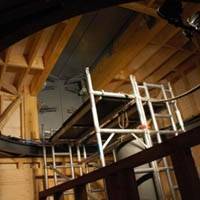With almost no light pollution from surrounding settlements the Kielder Observatory has breathtaking views of the night sky, according to the astronomers associated with the building.
It has been built in a remote part of the vast Kielder Water and Forest Park in Northumberland.

|
| Kielder Observatory. |
The angular, 246 square metre timber observatory structure was designed by Charles Barclay Architects to reflect the building's forest setting.
The observatory, which has two permanent telescopes, is the brain-child of Gary Fildes.
After several trips to the area for the Forestry Commission, Mr Fildes began lobbying for funds to put a telescope on the site.
But he said he was surprised by the enthusiasm of the observatory's sponsors.
"What I didn't realise and what I wasn't prepared for is the scale of which we could raise money to build a facility and the support we have had from the fundraisers has been absolutely superb," he said.
He added the outlook from the centre's main telescope is further enhanced because it is around 1500ft above sea level, giving a low horizon and panoramic views.
"It is very remote. When we're stood here on the hillside we can't see any other signs of civilisation," he said.
"What you tend to get is a crystal clear view of the night sky.
"So on a clear night the view is absolutely fantastic, it's astounding actually."
Mr Fildes said the main aim of the project was to open up this astronomical gem to the public.
The project was funded by a number of local and national organisations including the Forestry Commission, Northern Rock Foundation and the Kielder Partnership.
It will be run by the Kielder Astronomical Society, of which Mr Fildes is a founding member.
The society, run by avid amateur astronomers, will provide talks, tours and research projects at the observatory as well as organising overnight 'Star Camps'.
Events to look forward to from the new observatory include a near miss incident with a meteor, expected in 2029, and the next appearance of Halley's Comet in 2061.



Reader Comments
to our Newsletter